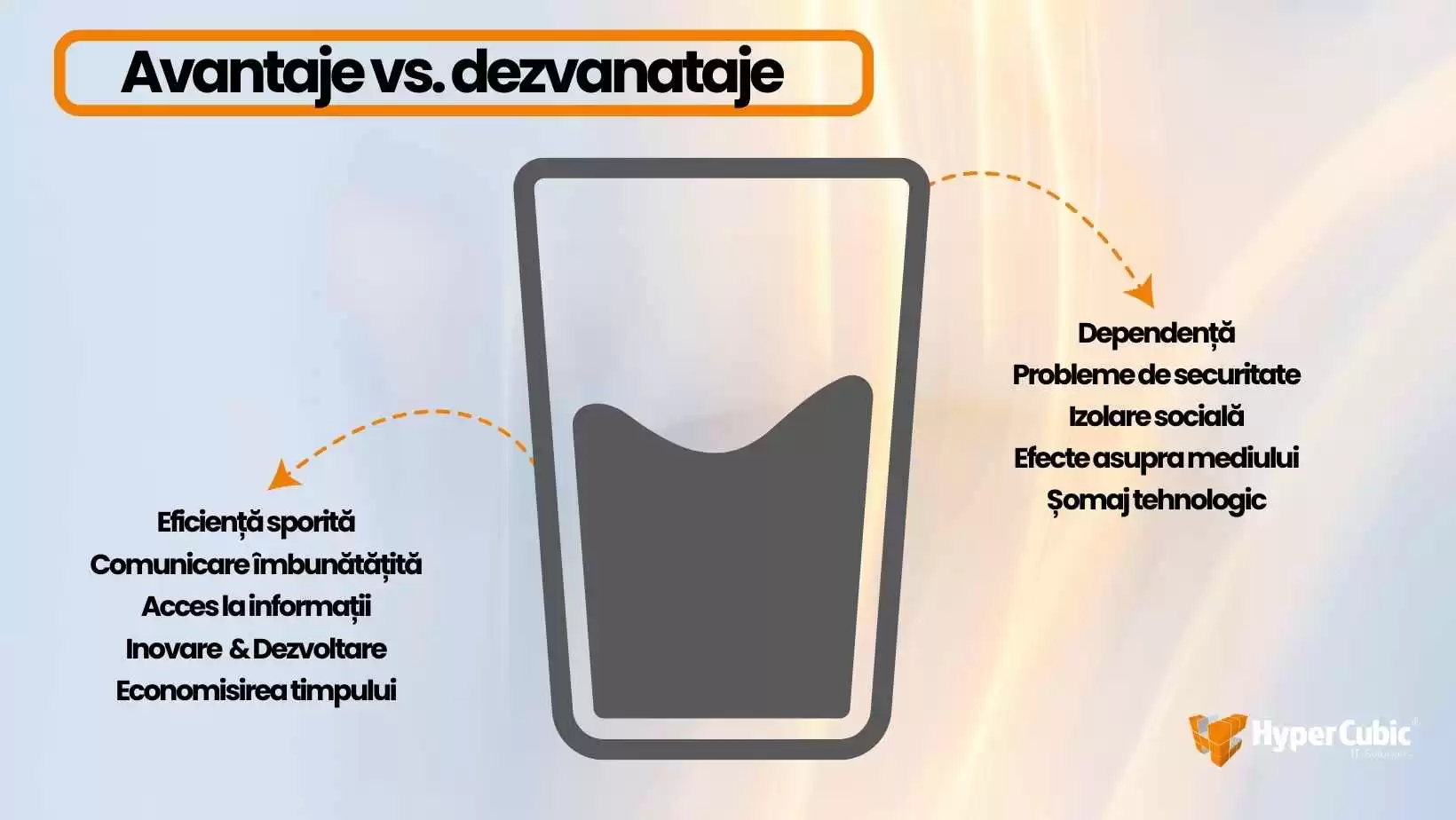In the digital age we live in, technology is all around us and impacts almost every aspect of our lives. From the smartphone we use every day, to artificial intelligence changing entire industries, technological progress is inevitable and increasingly weighs on strategic decision making, at a personal and especially business level.
But is this progress beneficial to the human condition and to the society in which we live?
Progress: the benefits of technology
There is no doubt that technology has brought countless benefits. Almost any information is now just a click away, thanks to the internet. Communicating at a distance in a globalised world has become easier and more efficient. Moreover, technology has opened doors to greater social inclusion. People with disabilities, for example, benefit from tools that make their lives easier and allow them to better integrate into society. And the examples certainly don’t stop there.

But what are the main, undeniable advantages of technological progress?
Increased efficiency is certainly the first that comes to mind. Technology can automate processes and tasks, leading to increased efficiency in many areas, from manufacturing and business to healthcare and education. As he said, technology has made global communication more accessible and faster. People can easily interact with others around the world via the internet and mobile devices, and access to information is constantly improving learning and informed decision-making.
Beyond all that, technology is driving innovation and development in many areas, including medicine, energy, transport and many others. And all of this converges into time savings and elimination of repetitive tasks.
Regress: The dark side of technology
However, we cannot ignore the negative impact that technology can have on us. Reliance on technology and social networking, for example, is a growing problem, while automation and artificial intelligence threaten the stability of jobs in certain specialisations. On top of this, technology has also had an impact on human relationships. Face-to-face communication is becoming increasingly rare, replaced by virtual interactions.
The loss of privacy poses more and more challenges. With all the benefits that connectivity brings, it also comes with the risk of privacy breaches. Technology can be vulnerable to cyber attacks, which can put personal data and information at risk.
People can become addicted to technology, which can lead to health problems such as eye conditions or psychological problems. What’s more, research suggests that young people spend an average of 7 hours a day in front of screens, which is not good for the long term. Social isolation also comes into play as the overuse of technology can lead to a decline in the quality of human relationships.
“The ‘information bubble’ is another aspect that is attracting increasing attention. Algorithms in social platforms often only present us with information that confirms our pre-existing beliefs, amplifying divisions and misunderstanding of complex realities.
The environmental effects are not negligible either. The production and disposal of e-waste has a negative impact on the environment. Last but not least, we are witnessing a rising tide of technological unemployment. Automation is gradually leading to job losses in some industries as machines and robots take over human tasks.
The future: the balance between progress and regression
Balancing the advantages and disadvantages of technology can be a challenge, as each person and situation may have different needs and priorities. The solution is not to reject technology, but to use it responsibly for the good of humanity.
Education and information are key. We should learn to use technology in a way that improves our lives without alienating or harming us.
In conclusion, technology can be both a blessing and a curse. There are, however, a few strategies to achieve a healthy balance, starting with awareness, prioritisation and evaluation of the intrusion of technology into everyday life.
Here are a few more ideas that show the blessing of technology:
- Personalised education: Technology can revolutionise education by providing teaching materials tailored to each student’s pace and learning style. This could reduce school drop-out rates and increase the quality of education.
- Technology in medicine: From 3D printing of organs to personalised gene therapies, the future of medicine looks promising. These innovations have the potential to eradicate disease and extend life.
- Clean energy: Investment in renewable energy technologies, such as more efficient solar panels or wind turbines, could lead to a future where dependence on fossil fuels is reduced, with a positive impact on the environment.
In the book Why Nations Fail: The Origins of Power, Prosperity and Poverty”, written by Daron Acemoglu and James Robinson, explores why some nations prosper while others remain in poverty, and it all starts from 2 categories of “institutions” – inclusive and extractive, the formation of which depends overwhelmingly on how technology is used.
The authors argue that inclusive institutions facilitate innovation, economic growth and development, while extractive institutions inhibit these processes and perpetuate poverty and inequality.
Inclusive institutions are characterised by openness and participation, where power and resources are relatively equitably distributed in society. These institutions create an enabling environment for innovation, individual initiative and sustainable economic development. On the other hand, extractive institutions are characterised by the concentration of power and resources in the hands of a small elite. They systematically exploit society and limit opportunities for most people, leading to poverty and economic stagnation.
But regardless of the approach, it is important to note that technology can significantly influence the direction a society takes in various ways.

- Innovation: Inclusive institutions are usually innovation-friendly. They promote research and development, giving people the freedom and resources to innovate. In contrast, extractive institutions may limit innovation, as it could threaten the status quo and elite power.
- Technology diffusion: Inclusive institutions tend to facilitate the rapid diffusion of technology, benefiting society as a whole. In extractive systems, the technology can be controlled or limited to keep power concentrated.
- Education: Access to education, especially in technological and scientific fields, is crucial for technological progress. Inclusive institutions promote an accessible and quality education system, essential to keep pace with technological innovation.
- Infrastructure: Technological development requires an appropriate infrastructure. Inclusive institutions invest in infrastructure such as internet, transport and energy networks, facilitating the adoption and use of technology.
- Regulations: Inclusive institutions create a regulatory framework that supports entrepreneurship and innovation, while in extractive systems, regulations can be used to inhibit competition or protect the interests of certain groups.
- Collaboration: Inclusive institutions encourage collaboration between different sectors, such as universities, industries and government, thus facilitating technology transfer and innovation.
If we look at a much smaller scale, at a limited ecosystem such as a company, we have to be aware that the same principles apply. How you manage and consume technology is critical to the long-term health and growth of your organisation.
From the way you facilitate access to information for educational or procedural purposes to the implementation of IT services or solutions that ensure data security, not employee monitoring and control, with the goals of functionality and productivity, all of these aspects define what kind of company you are or will become, what employees or customers you attract.
For example, if you want adaptability, scalability and the latest technology, opt for data-center IT solutions on a subscription basis rather than a one-off purchase, eliminating constraints and the perception of “out of data”.
And if the way you plan for the future of the company you run involves caring about employees and focusing on sustainable business development, you need to consider building an IT ecosystem where employees feel protected, included and where communication is easy.
Want to protect your identity? Think in terms of prevention and ensure business continuity by being able to restore your critical data.The sense of ownership is as present as it gets in on-premises acquisition decisions, but it hides a few pitfalls on which your company’s growth depends. One is that the allocated budget is perceived as a cost, not an investment, attracting maintenance costs. Another pitfall is that of being trapped in a “sedentary” technology.
In conclusion, technology is a powerful force that can change the direction of a society, a company, an individual in a variety of ways. It brings with it both significant opportunities and complex challenges. The benefits of technology can include economic growth, innovation, improved quality of life and global connectivity. However, it is essential to manage and regulate technology responsibly to minimise the downside.
Ultimately, technology is just a tool and it is up to us as a society, individuals, managers, employees to decide how we use it to shape the world we live in.




